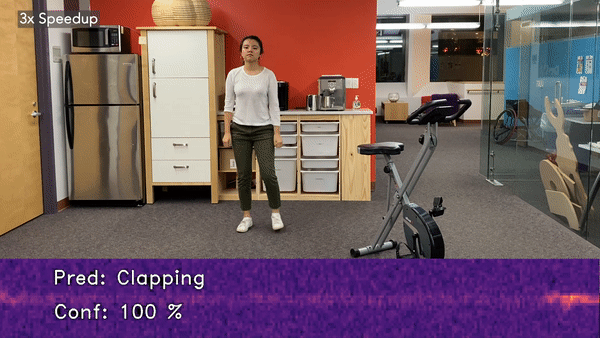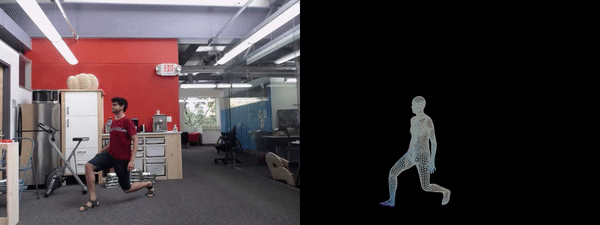Vid2Doppler: Synthesizing Doppler Radar Data from Videos for Training Privacy-Preserving Activity Recognition
This is the research repository for Vid2Doppler (CHI 2021) containing the code for:
- Generating synthetic Doppler data from videos
- Evaluating the activity recognition classifier trained on synthetically generated Doppler data only, on the real world Doppler dataset presented in the paper
More details for the project can be found here.

Environment Setup
We first recommend setting up conda or virtualenv to run an independent setup.
After cloning the git repository, in the Vid2Doppler folder:
- Create a conda environment:
conda create -n vid2dop python=3.7
conda activate vid2dop
pip install -r requirements.txt- Install the psbody library for the
meshvisualization. In particular:
git clone https://github.com/MPI-IS/mesh.gitIn the mesh folder, run:
BOOST_INCLUDE_DIRS=/path/to/boost/include make allNow go to the Python folder in Vid2Doppler and replace the meshviewer.py installed by pybody with the custom one:
cp meshviewer.py $CONDA_PREFIX/lib/python3.7/site-packages/psbody/mesh/meshviewer.pyIn case of using some other virtual environment manager, replace the meshviewer.py file installed by psbody with the one provided.
- Run the following command in the
Pythonfolder to get the pretrained VIBE pose model in the:source ../Environment/prepare_data.sh
Dataset and Models
Use the links below to download the:
- Real world Doppler dataset collected across 10 participants and 12 activities. Details found in paper here.
- Deep learning models for our classifier trained solely on synthetically generated Doppler data and encoder-decoder NN.
- Sample Videos for demo purposes.
You can download and unzip the above in the Vid2Doppler folder.
Usage
Run the following in the Python folder.
Synthetic Doppler Data Generation from Videos

doppler_from_vid.py generates synthetic Doppler data from videos. Run it on the sample_videos provided.
python doppler_from_vid.py --input_video YOUR_INPUT_VIDEO_FILE --model_path PATH_TO_DL_MODELS_FOLDER
Other options:
--visualize_mesh : output visualized radial velocity mesh (saved automatically in the output folder)
--doppler_gt : Use if the ground truth real world Doppler data is available for comparisonThe script outputs the synthetic data signal (saved with the suffix _output_signal) in the same folder as the input_video. Reference plot showcased below.

Human Activity Classification on Real World Doppler
doppler_eval.py has the code for evaluating the activity recogntion classifier trained on synthetically generated Doppler data and tested on the real world Doppler dataset.
python doppler_eval.py --data_path PATH_TO_DATASET_FOLDER --model_path PATH_TO_DL_MODELS_FOLDER Reference
Karan Ahuja, Yue Jiang, Mayank Goel, and Chris Harrison. 2021. Vid2Doppler: Synthesizing Doppler Radar Data from Videos for Training Privacy-Preserving Activity Recognition. In Proceedings of the 2021 CHI Conference on Human Factors in Computing Systems (CHI '21). Association for Computing Machinery, New York, NY, USA, Article 292, 1–10. DOI:https://doi.org/10.1145/3411764.3445138
BibTex Reference:
@inproceedings{10.1145/3411764.3445138,
author = {Ahuja, Karan and Jiang, Yue and Goel, Mayank and Harrison, Chris},
title = {Vid2Doppler: Synthesizing Doppler Radar Data from Videos for Training Privacy-Preserving Activity Recognition},
year = {2021},
isbn = {9781450380966},
publisher = {Association for Computing Machinery},
address = {New York, NY, USA},
url = {https://doi.org/10.1145/3411764.3445138},
doi = {10.1145/3411764.3445138},
articleno = {292},
numpages = {10},
keywords = {HAR, Datasets, Cross domain translation, Privacy-preserving sensing, Doppler sensing, Human activity recognition},
location = {Yokohama, Japan},
series = {CHI '21}
}Vid2Doppler makes use of VIBE and Psbody. Please cite them and be respectful of their licenses as well.
License
GPL v 2.0 License file present in repo. Please contact innovation@cmu.edu if you would like another license for your use.